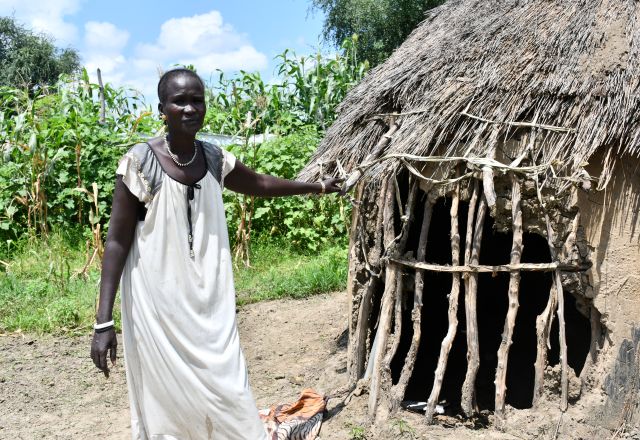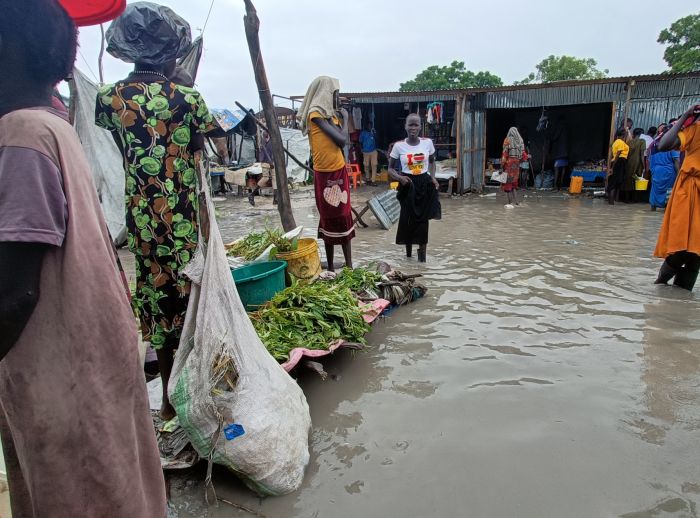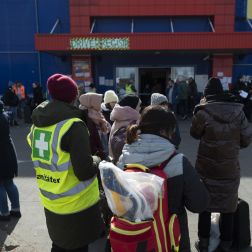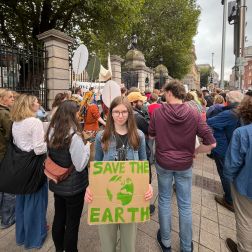
It rained for about a week, and my house was submerged and started to collapse as water soaked the walls
- 5 mins read time
- Published: 17th October 2024
Children and Mothers at risk of malnutrition and disease as floods inundate Lankien
As the rainy season continues in South Sudan, 2.3 million people across the country once again find themselves living in areas likely to face floods, with already 1 million others battling the impact of previous floods, which have become a recurring and devastating challenge.
The heavy rains expected to persist until November 2024, continue to displace vulnerable communities, leaving a trail of destruction in its wake. This is the sixth year in a row that rains done havoc on communities in low-lying areas across South Sudan.
In Lankien payam of Nyirol County in South Sudan, Nyalam Tut a 32-year-old mother of six says her face, etched with countless times of pain as she has been displaced, each rainy season bringing up sorrows from the past.
It rained for about a week, and my house was submerged and started to collapse as water soaked the walls,” Nyalam recalls, her voice tinged with sorrow. “I had to take my children to the nearby local authority building, which is on slightly higher ground. But when I returned the next day to collect some essentials, thieves had broken in and taken everything, including our clothes, while the rains submerged the remaining essentials.” said Nyalam.

Over 1,020 of people from Nyirol county, fled their homes and sought shelter with the help of local authority where they were resettled in a makeshift facility from the submerged homes. Although out in the open and they are exposed to mosquitoes and cold, Nyalam is content that it is slightly safer from being flooded homes for her family.
We are on higher ground, but with no shelter. Only the children were taken to a small room to protect them from the rain. As adults, we sleep outside. However, due to the cold and mosquitoes, we started getting sick with pneumonia, malaria and diarrhoea while at the makeshift homes. As you can see right now, our houses are submerged, and it is difficult for us to cope with all the issues we have.”, Nyalam explains.
As is the case with past floods, communities are left with little to no food, as floods have washed away crops, leaving families with very little to eat or expecting to harvest. Livestock, a key source for milk and meat among communities continue to drown, further compounding to the crisis.
For Nyalam’s children, the situation is dire.
“As you can see, my youngest daughter is already malnourished. The other children are sick with malaria and diarrhoea. We don’t have mosquito nets because everything we had was stolen or washed away. Even our toilet has collapsed, —it’s extremely bad. If we could get support with non-food items like plastic sheets, I could use them to renovate the house.”
Nyalam, is just one of 170 households affected by the current floods in Lankien, the Relief and Rehabilitation Commission (RRC) in Nyirol county says.
Current water levels in the River Nile at the Mangala Gauging Station have shown a significant increase, indicating potential flood risks.
In 2023, an estimated 850,000 people were affected by devastating floods, with over 380,000 uprooted from their homes. With more rains predicted this, year, the figure is likely to surpass 2023 effects.
In South Sudan, more than half the population – over 7 million people – are already facing extreme hunger, including nearly 79,000 people facing catastrophic levels of food insecurity, which is more than double that of last year.
Climate change is real, has started to cause heart-wrenching suffering in South Sudan. Thousands of people both young and old are hungry and children severely malnourished; more than 2.3 million people are likely to be displaced. Since May, over 710,000 people have been affected by floods resulting from the controlled release of water from Lake Victoria and recent heavy rains across the country, and social amenities are getting significantly affected.— Dr. Manenji Mangundu, Oxfam South Sudan Country Director
According to the recently released UNOCHA’s flood highlights as of 29 August 2024, floods have affected 472,000 people across 26 of South Sudan's 78 counties. The affected regions, including Northern Bahr el Ghazal, Warrap, Western Bahr el Ghazal, Jonglei, Unity, Upper Nile, and Central Equatoria, are already grappling with compounded challenges such as previous floods, ongoing conflict, displacement, food insecurity, and the broader regional impact of the Sudan crisis.
Oxfam urgently needs $15 million to scale up its operations and save lives of vulnerable children and women affected by the conflict, floods and diseases.
“Failing to respond when people are starving is a moral failing that must not continue. Without urgent assistance, now we risk many more lives. Humanitarian assistance delayed is aid denied, donors must act now,” Manenji says.
Record-level flooding is forecasted for this rainy season (June- September), and likely to decimate crops and probably push approximately 2.3 million already vulnerable people to a breaking point.




